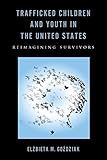Trafficked Children and Youth in the United States : Reimagining Survivors / Elzbieta M. Gozdziak.
Material type: TextSeries: Rutgers Series in Childhood StudiesPublisher: New Brunswick, NJ : Rutgers University Press, [2016]Copyright date: ©2016Description: 1 online resource (194 p.) : 3 tablesContent type:
TextSeries: Rutgers Series in Childhood StudiesPublisher: New Brunswick, NJ : Rutgers University Press, [2016]Copyright date: ©2016Description: 1 online resource (194 p.) : 3 tablesContent type: - 9780813569697
- 9780813569710
- 306.74/5 23
- HQ144 .G779 2016
- online - DeGruyter
- Issued also in print.
| Item type | Current library | Call number | URL | Status | Notes | Barcode | |
|---|---|---|---|---|---|---|---|
 eBook
eBook
|
Biblioteca "Angelicum" Pont. Univ. S.Tommaso d'Aquino Nuvola online | online - DeGruyter (Browse shelf(Opens below)) | Online access | Not for loan (Accesso limitato) | Accesso per gli utenti autorizzati / Access for authorized users | (dgr)9780813569710 |
Browsing Biblioteca "Angelicum" Pont. Univ. S.Tommaso d'Aquino shelves, Shelving location: Nuvola online Close shelf browser (Hides shelf browser)

|

|

|

|

|

|

|
||
| online - DeGruyter Labor of Love : Gestational Surrogacy and the Work of Making Babies / | online - DeGruyter The Road to Citizenship : What Naturalization Means for Immigrants and the United States / | online - DeGruyter Envisioning New Jersey : An Illustrated History of the Garden State / | online - DeGruyter Trafficked Children and Youth in the United States : Reimagining Survivors / | online - DeGruyter Battleground New Jersey : Vanderbilt, Hague, and Their Fight for Justice / | online - DeGruyter Police, Power, and the Production of Racial Boundaries / | online - DeGruyter Saving Face : The Emotional Costs of the Asian Immigrant Family Myth / |
Frontmatter -- Contents -- Acknowledgments -- Prologue: Afong Means Strength -- Introduction: Researching and Writing about Child Trafficking -- Part I. Moral Panics -- Part II. "Captured" -- Part III. "Rescued" -- Part IV. "Restored" -- Epilogue: Everyday Struggles -- Notes -- Bibliography -- Index -- About the Author
restricted access online access with authorization star
http://purl.org/coar/access_right/c_16ec
Trafficked children are portrayed by the media-and even by child welfare specialists-as hapless victims who are forced to migrate from a poor country to the United States, where they serve as sex slaves. But as Elzbieta M. Gozdziak reveals in Trafficked Children in the United States, the picture is far more complex. Basing her observations on research with 140 children, most of them girls, from countries all over the globe, Gozdziak debunks many myths and uncovers the realities of the captivity, rescue, and rehabilitation of trafficked children. She shows, for instance, that none of the girls and boys portrayed in this book were kidnapped or physically forced to accompany their traffickers. In many instances, parents, or smugglers paid by family members, brought the girls to the U.S. Without exception, the girls and boys in this study believed they were coming to the States to find employment and in some cases educational opportunities. Following them from the time they were trafficked to their years as young adults, Gozdziak gives the children a voice so they can offer their own perspective on rebuilding their lives-getting jobs, learning English, developing friendships, and finding love. Gozdziak looks too at how the children's perspectives compare to the ideas of child welfare programs, noting that the children focus on survival techniques while the institutions focus, not helpfully, on vulnerability and pathology. Gozdziak concludes that the services provided by institutions are in effect a one-size-fits-all, trauma-based model, one that ignores the diversity of experience among trafficked children. Breaking new ground, Trafficked Children in the United States offers a fresh take on what matters most to these young people as they rebuild their lives in America.
Issued also in print.
Mode of access: Internet via World Wide Web.
In English.
Description based on online resource; title from PDF title page (publisher's Web site, viewed 30. Aug 2021)


